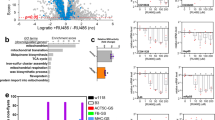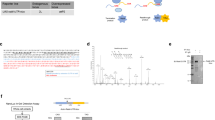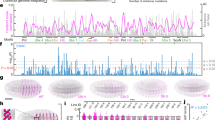Abstract
The period (per) locus, which controls biological rhythms in Drosophila, was originally defined by three chemically induced mutations1. Flies carrying the per° mutation were arrhythmic, whereas pers and perl mutants had circadian behavioural rhythms with 19-hour and 29-hour periodicities, respectively1. Wild-type flies have 24-hour rhythms. Here we compare the per locus DNA sequences of the three mutants with the parental wild-type. The pers and perl mutations lead to amino-acid substitutions, whereas per° introduces an early translation stop (amber). The results indicate that the protein product of per controls biological rhythms. We also report that the abundance of this protein may set the pace of the Drosophila clock. Although circadian rhythms are restored when arrhythmic (per–) Drosophila are transformed with per locus DNA, flies receiving identical transforming DNA segments can produce rhythms with periods that differ by more than 12 hours. Transcription studies reveal a tenfold variation in the level of per RNA among transformed lines. Levels of per RNA are inversely correlated with period length, so that flies with lowest levels of the per product have slow-running biological clocks. On the basis of the combined studies we suggest that perl and pers mutants produce hypoactive and hyperactive per proteins, respectively.
This is a preview of subscription content, access via your institution
Access options
Subscribe to this journal
Receive 51 print issues and online access
$199.00 per year
only $3.90 per issue
Buy this article
- Purchase on Springer Link
- Instant access to full article PDF
Prices may be subject to local taxes which are calculated during checkout
Similar content being viewed by others
References
Konopka, R. & Benzer, S. Proc. natn. Acad. Sci. U.S.A. 68, 2112–2116 (1971).
Bargiello, T. A. & Young, M. W. Proc. natn. Acad. Sci. U.S.A. 81, 2142–2146 (1984).
Reddy, P. et al. Cell 38, 701–710 (1984).
Young, M. W., Jackson, F. R., Shin, H. S. & Bargiello, T. A. Cold Spring Harb. Symp. quant. Biol. 50, 865–875 (1985).
Jackson, F. R., Bargiello, T. A., Yun, S-H. & Young, M. W. Nature 320, 185–188 (1986).
Bargiello, T. A., Jackson, F. R. & Young, M. W. Nature 312, 752–754 (1984).
Smith, R. F. & Konopka, R. J. Molec. gen. Genet. 183, 243–251 (1981).
Smith, R. F. & Konopka, R. J. Molec. gen. Genet. 185, 30–36 (1982).
Cote, G. & Brody, S. J. theor. Biol. 121, 487–503 (1986).
Spradling, A. C. & Rubin, G. M. Cell 34, 47–57 (1983).
Goldberg, D. A., Posakony, J. W. & Maniatis, T. Cell 34, 59–73 (1983).
Pittendrigh, C. S. Proc. natn. Acad. Sci. U.S.A. 40, 1018–1029 (1954).
Pittendrigh, C. S. in Handbook of Behavioral Neurobiology Vol. 4 (ed. Aschoff, J.) 95–124 (Plenum, New York, 1981).
Zehring, W. A. et al. Cell 39, 369–376 (1984).
Hamblen, M. et al. J. Neurogenet. 3, 249–291 (1986).
Young, M. W. & Judd, B. H. Genetics 88, 723–742 (1978).
Fyrberg, E. A., Mahaffey, J. W., Bond, B. J. & Davidson, N. Cell 33, 115–123 (1983).
Dale, R. M. K., McClure, B. A. & Houchins, J. P. Plasmid 13, 31–40 (1985).
Sanger, F., Coulson, A. R., Barrell, B. G., Smith, A. J. H. & Roe, B. A. J. molec. Biol. 143, 161–178 (1980).
Biggin, M. D., Gibson, T. J. & Hong, G. F. Proc. natn. Acad. Sci. U.S.A. 80, 3963–3965 (1983).
Shin, H. S., Bargiello, T. A., Clark, B. T., Jackson, F. R. & Young, M. W. Nature 317, 445–448 (1985).
Reddy, P., Jacquier, A. C., Abovich, N., Peterson, G. & Rosbash, M. Cell 46, 53–61 (1986).
Citri, Y. et al. Nature 326, 42–47 (1987).
Author information
Authors and Affiliations
Rights and permissions
About this article
Cite this article
Baylies, M., Bargiello, T., Jackson, F. et al. Changes in abundance or structure of the per gene product can alter periodicity of the Drosophila clock. Nature 326, 390–392 (1987). https://doi.org/10.1038/326390a0
Received:
Accepted:
Issue Date:
DOI: https://doi.org/10.1038/326390a0
This article is cited by
-
Regulation of insect behavior by non-coding RNAs
Science China Life Sciences (2024)
-
Circadian and Genetic Modulation of Visually-Guided Navigation in Drosophila Larvae
Scientific Reports (2020)
-
Genome-Wide Association Study of Circadian Behavior in Drosophila melanogaster
Behavior Genetics (2019)
-
The circadian mutation PER2S662G is linked to cell cycle progression and tumorigenesis
Cell Death & Differentiation (2012)
-
Stochastic synchronization of circadian rhythms
Journal of Systems Science and Complexity (2010)
Comments
By submitting a comment you agree to abide by our Terms and Community Guidelines. If you find something abusive or that does not comply with our terms or guidelines please flag it as inappropriate.



